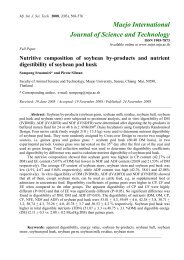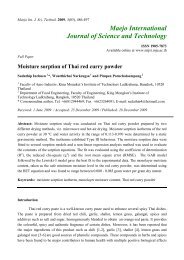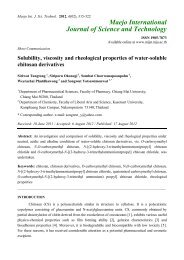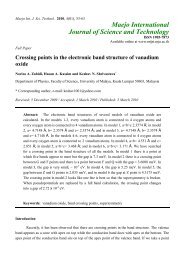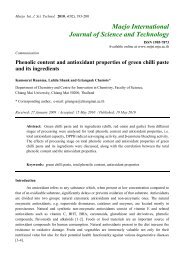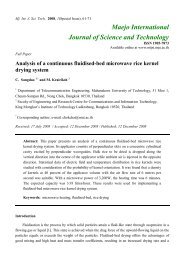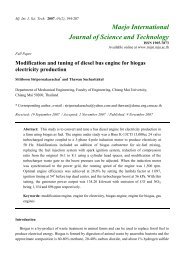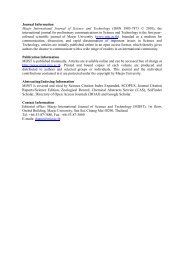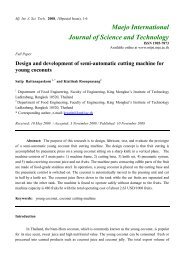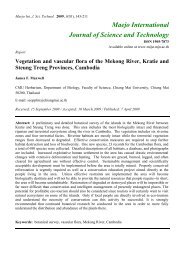Effect of Glomus mosseae and plant growth promoting ...
Effect of Glomus mosseae and plant growth promoting ...
Effect of Glomus mosseae and plant growth promoting ...
- No tags were found...
Create successful ePaper yourself
Turn your PDF publications into a flip-book with our unique Google optimized e-Paper software.
Mj. Int. J. Sci. Tech. 2008, 2(03), 516-525Maejo InternationalFull PaperJournal <strong>of</strong> Science <strong>and</strong> TechnologyISSN 1905-7873Available online at www.mijst.mju.ac.th<strong>Effect</strong> <strong>of</strong> <strong>Glomus</strong> <strong>mosseae</strong> <strong>and</strong> <strong>plant</strong> <strong>growth</strong> <strong>promoting</strong>rhizomicroorganisms (PGPR's) on <strong>growth</strong>, nutrients <strong>and</strong> content<strong>of</strong> secondary metabolites in Begonia malabarica Lam.Thangavel Selvaraj 1,* , Sevanan Rajeshkumar 2 , Mathan C. Nisha 3 ,Mitiku Tesso 1Lakew Wondimu 2 , <strong>and</strong>1 Department <strong>of</strong> Plant Sciences, Faculty <strong>of</strong> Agricultural Sciences, Ambo University College, Post BoxNo.19, Ambo, Ethiopia2Department <strong>of</strong> Applied Biology, Ambo University College, Post Box No.19, Ambo, Ethiopia3Department <strong>of</strong> Botany, Kongunadu Arts <strong>and</strong> Science College (Autonomous), Coimbatore, Tamilnadu,India* Corresponding Author, e-mail: tselvaraj_1956@yahoo.comReceived: 31 March 2008 / Accepted: 13 October 2008 / Published: 15 October 2008__________________________________________________________________________________Abstract: Begonia malabarica Lam. (Begoniaceae) is one <strong>of</strong> the important medicinal <strong>plant</strong>swhose main secondary metabolites are luteolin, quercetin <strong>and</strong> β-sitosterol. The leaves are used for thetreatment <strong>of</strong> respiratory tract infections, diarrhoea, blood cancer <strong>and</strong> skin diseases. A study wasundertaken to determine the effect <strong>of</strong> arbuscular mycorrhizal (AM) fungus, <strong>Glomus</strong> <strong>mosseae</strong>, <strong>and</strong> some<strong>plant</strong> <strong>growth</strong> <strong>promoting</strong> rhizomicro-organisms (PGPR's) on the <strong>growth</strong>, biomass, nutrients, <strong>and</strong> content<strong>of</strong> secondary metabolites <strong>of</strong> B. malabarica <strong>plant</strong> under green house conditions. Various <strong>plant</strong> <strong>growth</strong>parameters (total <strong>plant</strong> biomass, mycorrhizal parameter, shoot <strong>and</strong> root phosphorus), mineral content(potassium, iron, zinc, <strong>and</strong> copper), <strong>and</strong> secondary metabolites (total phenols, ortho-dihydroxy phenols,tannins, flavonoids, <strong>and</strong> alkaloids) were determined <strong>and</strong> found to vary with different treatments. Amongall the treatments, <strong>plant</strong>s inoculated with 'microbial consortium' consisting <strong>of</strong> <strong>Glomus</strong> <strong>mosseae</strong> +Bacillus coagulans + Trichoderma viride performed better than with other treatments or uninoculatedcontrol <strong>plant</strong>s. The results <strong>of</strong> this experiment clearly indicated that inoculation <strong>of</strong> B. malabarica with G.<strong>mosseae</strong> along with PGPR's enhanced its <strong>growth</strong>, biomass yield, nutrients <strong>and</strong> secondary metabolites.
Mj. Int. J. Sci. Tech. 2008, 2(03), 516-525517Keywords: Begonia malabarica, <strong>Glomus</strong> <strong>mosseae</strong>, PGPR's, Bacillus coagulans, Trichoderma viride,secondary metabolitesIntroductionEcosystems are composed <strong>of</strong> many organisms interacting in a multiple complex relationshipswith their environment <strong>and</strong> with each other. Biological relationships may be antagonistic, neutral orbeneficial [1]. Utilisation <strong>of</strong> bi<strong>of</strong>ertilisers in the cultivation <strong>of</strong> medicinal <strong>and</strong> aromatic <strong>plant</strong>s is <strong>of</strong> recentinterest. An introduction <strong>of</strong> arbuscular mycorrhizal (AM) fungi is known to increase the <strong>growth</strong> <strong>of</strong> many<strong>plant</strong> species including medicinal <strong>plant</strong>s. This is attributed to an increased uptake <strong>of</strong> nutrients,production <strong>of</strong> <strong>growth</strong> <strong>promoting</strong> substances <strong>and</strong> phytochemical constituents, tolerance to drought,salinity, trans<strong>plant</strong> shock, resistance to <strong>plant</strong> pathogens, <strong>and</strong> synergistic interaction with other beneficialsoil microorganisms such as N2-fixers <strong>and</strong> P-solubilisers [2-4]. It has been established that mycorrhizal<strong>plant</strong>s grow better in infertile soils because <strong>of</strong> improved mineral nutrients through hyphae, which help inexploring a greater volume <strong>of</strong> soil beyond root hairs [5,6].With the advent <strong>of</strong> innovative technologies <strong>and</strong> the importance being given to sustainableagriculture, AM fungal association is <strong>of</strong> great economic significance on the <strong>growth</strong> <strong>of</strong> agricultural <strong>and</strong>medicinal crops. Certain <strong>plant</strong> <strong>growth</strong> <strong>promoting</strong> rhizomicroorganisms (PGPRs) have been reported toenhance the activity <strong>of</strong> mycorrhizal fungi <strong>and</strong> consequently <strong>plant</strong> <strong>growth</strong> [7-13]. Therefore microbialinoculants can help maintain good soil health <strong>and</strong> fertility that contribute to a greater extent to asustainable yield <strong>and</strong> quality <strong>of</strong> products [1]. However, the information available on the use <strong>of</strong> thesebeneficial microorganisms in medicinal <strong>plant</strong>s is meagre.Begonia malabarica Lam. is one <strong>of</strong> the important medicinal <strong>plant</strong>s, belonging to the familyBegoniaceae <strong>and</strong> commonly called as 'rathasoori' or 'senth<strong>and</strong>u'. The main secondary metabolites <strong>of</strong> B.malabarica are luteolin, quercetin <strong>and</strong> β-sitosterol [14]. The leaves are used for the treatment <strong>of</strong>respiratory tract infections, diarrhoea, blood cancer, <strong>and</strong> skin diseases [14]. It is found to grow inlateritic <strong>and</strong> acidic soil. Lateritic soil is, in general, poor in nutritional status <strong>and</strong> is especially deficient inphosphorus. The present study was undertaken to study the effect <strong>of</strong> AM fungus, <strong>Glomus</strong> <strong>mosseae</strong> <strong>and</strong>the PGPRs, Bacillus coagulans <strong>and</strong> Trichoderma viride, singly <strong>and</strong> in combination on the <strong>growth</strong>,biomass, nutrients, <strong>and</strong> content <strong>of</strong> secondary metabolites <strong>of</strong> B. malabarica raised under glasshousecondition.
Mj. Int. J. Sci. Tech. 2008, 2(03), 516-525518Materials <strong>and</strong> MethodsB. malabarica seedlings were raised in seed pans containing a s<strong>and</strong>:soil mix (1:1 v/v). Theseedlings after germination were maintained for four weeks. G. <strong>mosseae</strong> maintained as a pot cultureusing sterilised s<strong>and</strong>:soil mix (1:1 v/v) as the substrate <strong>and</strong> guinea grass (Panicum maximum Jacq.) asthe host was used in the present study. The substrate along with the roots <strong>of</strong> guinea grass was air-dried.The hyphae, spores <strong>and</strong> root segments in the dried substrate served as the mycorrhizal inoculum.Bacillus coagulans, which is not only a PGPR but also a mycorrhiza helper bacterium (MHB) wasgrown in nutrient broth <strong>and</strong> Trichoderma viride in potato dextrose broth each in a 2-L flask containing800 ml medium. After 3 days <strong>of</strong> <strong>growth</strong> for B. coagulans <strong>and</strong> 7 days for T. viride, the cultures wereused for inoculation along with G. <strong>mosseae</strong> at the time <strong>of</strong> sowing <strong>and</strong> the <strong>plant</strong>s were maintained in aglasshouse for 90 days. The microbial cultures were separately mixed with sterile lignite powder <strong>and</strong>their populations were determined by serial dilution plate method.Pots <strong>of</strong> 4.5-kg capacity were filled with a s<strong>and</strong>y loam soil:s<strong>and</strong> (1:1 by volume) potting mix. Thesoil used was <strong>of</strong> an alfisol-type kaolinitic, isohyperthemic typic kanhaplustafs. The potting mixture had apH <strong>of</strong> 6.2 <strong>and</strong> contained 2.7 ppm available phosphate (NH 4 F + HCl extractable). A <strong>plant</strong>ing hole wasmade at the centre <strong>of</strong> the pot. Ten grams each <strong>of</strong> <strong>of</strong> G. <strong>mosseae</strong> (1400 IP g -1 ), B. coagulans (2.8 X 10 8cfu g -1 ), <strong>and</strong> T. viride (3.4 X 10 8 cfu g -1 ) inocula were added as per the treatment allocation shown inTable 1. One seedling was maintained per pot with 5 replications for each treatment. The <strong>plant</strong>s werekept in a glasshouse <strong>and</strong> watered regularly.The <strong>plant</strong>s were harvested 90 days after <strong>plant</strong>ing. Growth parameters, viz. <strong>plant</strong> height, number<strong>of</strong> leaves <strong>and</strong> branches were recorded at harvest. Dry weight <strong>of</strong> shoot <strong>and</strong> root was recorded afterdrying the samples at 60ºC to constant weight in a hot air oven. The phosphorus <strong>and</strong> potassium content<strong>of</strong> the <strong>plant</strong>s were estimated by vanadomolybdate phosphoric acid <strong>and</strong> flame photometric methodrespectively [15]. An atomic absorption spectrophotometre was employed to estimate zinc, copper <strong>and</strong>iron content <strong>of</strong> the <strong>plant</strong> leaf samples, using respective hollow cathode lamps. Acid phosphatase activitywas estimated in the root-zone soil as per the procedure given by Tabatabai [16]. The contents <strong>of</strong>secondary metabolites, i.e. total phenols [17], ortho dihydroxy phenols [18], flavonoids [19], alkaloids[20] <strong>and</strong> tannins [21] were assayed in the <strong>plant</strong> leaf samples.Mycorrhizal root colonisation was determined by grid-line intersect method [22] after stainingthe root samples with acid fuchsin (0.2%) [23]. Extrametrical chlamydospore numbers in the root-zonesoil were enumerated by wet-sieving <strong>and</strong> decantation method [24]. The data thus generated were
Mj. Int. J. Sci. Tech. 2008, 2(03), 516-525519subjected to statistical analysis <strong>of</strong> completely r<strong>and</strong>omised block design <strong>and</strong> the means were separated byDuncan's Multiple Range Test [25].Results <strong>and</strong> DiscussionIn general, inoculants appreciably enhanced <strong>plant</strong> height especially for B. coagulans treatment(29.2 cm) (Table1), which was significantly superior over other treatments. This was followed by<strong>Glomus</strong> <strong>mosseae</strong> + Bacillus coagulans + Trichoderma viride (28.0 cm). There was no significantdifference in the number <strong>of</strong> leaves <strong>and</strong> branches <strong>of</strong> PGPR-inoculated <strong>and</strong> uninoculated control <strong>plant</strong>s.The maximum number <strong>of</strong> leaves <strong>and</strong> branches on 90 days after trans<strong>plant</strong>ing (DAT) were recorded in<strong>plant</strong>s inoculated with G. <strong>mosseae</strong> + B. coagulans + T. viride (32.4/<strong>plant</strong> <strong>and</strong> 5.2/<strong>plant</strong> respectively),which was significant over all other treatments, the lowest number <strong>of</strong> leaves <strong>and</strong> branches beingrecorded in control <strong>plant</strong>s (Table 1). Such a response <strong>of</strong> improved <strong>plant</strong> <strong>growth</strong> was also obtained in theinvestigation <strong>of</strong> Earanna et al. for Periwinkle [11] <strong>and</strong> <strong>of</strong> Sivakumar et al. for Pelargonium graveolensinoculated with <strong>Glomus</strong> fasciculatum <strong>and</strong> some PGPR's [12].Single inoculation with G. <strong>mosseae</strong> or dual inoculation with G. <strong>mosseae</strong> + B. coagulans alsosignificantly enhanced the total dry weight <strong>of</strong> B. malabarica <strong>plant</strong>s. Those similarly inoculated with G.<strong>mosseae</strong> + B. coagulans + T. viride showed maximum shoot <strong>and</strong> root dry weight (9.7 g/<strong>plant</strong>), thelowest biomass being recorded in control (Table 1). This may be due to synergistic interaction <strong>of</strong> theAM fungi <strong>and</strong> PGPRs in the rhizosphere <strong>of</strong> the <strong>plant</strong>s [3,8,12].Table 1. <strong>Effect</strong> <strong>of</strong> AM fungus <strong>and</strong> PGPRs on <strong>growth</strong> <strong>and</strong> biomass <strong>of</strong> B. malabaricaTreatmentPlantheight(cm)90 DAT Plant biomass (g/<strong>plant</strong>)No. <strong>of</strong>leavesNo. <strong>of</strong>branchesShoot Root TotalUninoculated control 16.5 e 16.2 e 3.2 e 1.3 d 1.4 d 2.7 eG.m + B.c + T.v28.0 a 32.4 a 5.2 a 5.6 a 4.9 a 9.7 a<strong>Glomus</strong> <strong>mosseae</strong> (G.m) 26.8 c 25.6 d 4.4 c 5.4 c 4.2 b 9.6 aBacillus coagulans (B.c) 29.2 a 20.6 e 3.5 d 5.5 a 2.2 d 7.7 cTrichoderma viride (T.v) 16.5 e 20.8 e 3.6 d 1.4 d 1.8 e 3.2 dG.m + B.c28.5 b 30.1 b 4.8 b 5.4 b 4.2 b 9.6 aG.m + T.v26.5 c 29.6 c 4.6 c 4.8 c 4.2 b 9.0 bB.c + T.v20.5 d 28.9 c 4.8 b 4.6 c 4.0 c 8.6 bNote: Means in the same column followed by the same superscript do not differ significantly accordingto Duncan's Multiple Range Test (P< 0.05).
Mj. Int. J. Sci. Tech. 2008, 2(03), 516-525520Maximum per cent root colonisation were recorded in the <strong>plant</strong>s inoculated with G. <strong>mosseae</strong> +B. coagulans + T. viride (95.2 %) (Table 2). Similarly, spore number was maximum when the <strong>plant</strong>swere inoculated with G. <strong>mosseae</strong> + B. coagulans (682.4/100g soil) <strong>and</strong> G. <strong>mosseae</strong> + B. coagulans + T.viride (585.2/100 g soil), the lowest number being recorded in uninoculated control <strong>plant</strong>s (Table 2).Synergistic interactions have been reported between the free-living rhizosphere bacteria, N 2 fixingorganisms <strong>and</strong> mycorrhizal fungi [26,11] with respect to the per cent root colonisation <strong>and</strong> sporenumber.The leaf phosphorus, potassium, zinc, copper <strong>and</strong> iron content were maximum in the <strong>plant</strong>streated with G. <strong>mosseae</strong> + B. coagulans + T. viride (27.14 mg/<strong>plant</strong>, 15.2 mg/<strong>plant</strong>, 507.2µg/<strong>plant</strong>,89.2 µg/g, <strong>and</strong> 94.2 µg/g respectively), in contrast with the <strong>plant</strong>s inoculated with G. <strong>mosseae</strong> alone(15.20 mg/<strong>plant</strong>; 10.5 mg/<strong>plant</strong>; 160.5 µg/g, 53.6 µg/g <strong>and</strong> 60.5 µg/g respectively) (Table 2). This isprobably due to the enhanced mycorrhizal colonisation. The phosphorus, potassium, zinc, copper <strong>and</strong>iron content were lowest in the uninoculated control <strong>plant</strong>. Such an increased P, K, Zn, Cu <strong>and</strong> Feuptake due to mycorrhizal inoculation with PGPRs was also reported by earlier workers [3,27].The acid phosphatase activity in the root-zone soil <strong>of</strong> all the inoculated seedlings wassignificantly higher compared to that in the root-zone soil <strong>of</strong> uninoculated control <strong>plant</strong>s. The highestvalue was recorded in the root zone <strong>of</strong> the <strong>plant</strong>s inoculated with G. <strong>mosseae</strong> + B. coagulans + T.viride (33.5 µ/g soil/hr), followed by that <strong>of</strong> the G. <strong>mosseae</strong> + B. coagulans-inoculated <strong>plant</strong>s (23.03µ/g soil/hr) (Table 2). Enhanced acid phosphatase activity in the root-zone soil <strong>of</strong> Neem due toinoculation with AM fungi was also reported earlier [28].
Mj. Int. J. Sci. Tech. 2008, 2(03), 516-525521Table 2. Influence <strong>of</strong> AM fungus <strong>and</strong> PGPRs on % root colonisation, spore number in the root zone soil, <strong>and</strong> nutrient status inthe leaves <strong>of</strong> B.malabaricaTreatmentUninoculated control<strong>Glomus</strong> <strong>mosseae</strong> (G.m)Bacillus coagulans (B.c)Trichoderma viride (T.v)G.m + B.cG.m + T.vB.c + T.vG.m + B.c + T.vPercent rootcolonisationSpore number/100 g <strong>of</strong> soilLeafP(mg/<strong>plant</strong>)LeafK(mg/<strong>plant</strong>)LeafZn(µg/g)LeafCu(µg/g)LeafFe(µg/g)28.9 e87.2 b30.5 d31.2 d83.5 b62.8 c45.2 d95.2 a 124.0 e482.6 b160.5 d140.6 d682.4 a320.5 c285.0 cd585.2 a 1.58 e15.20 c3.40 d3.08 d20.22 b16.56 c13.45 bc27.14 a 2.2 f10.5 c2.8 e2.9 e12.5 b11.4 b8.2 d15.2 a 38.6 f160.5 d56.2 e62.0 e394.5 b251.8 c120.2 d507.2 a 18.6 e53.6 c42.5 d40.2 d60.8 b56.8 c38.4 d89.2 a 22.4 e60.5 c48.2 d41.5 d92.5 b90.5 b85.6 b94.0 a 5.06 eAcidphosphataseactivity(µg/gsoil/hr)14.40 c6.02 d6.08 d23.03 b13.03 c18.05 c33.5 aNote: Means in the same column followed by the same superscript do not differ significantly according to Duncan's MultipleRange Test (P< 0.05).
Mj. Int. J. Sci. Tech. 2008, 2(03), 516-525522The leaf secondary metabolites (total phenols, ortho dihydroxy phenols, flavonoids, alkaloids<strong>and</strong> tannins) were maximum in the <strong>plant</strong>s treated with G. <strong>mosseae</strong> + B. coagulans + T. viride (129.8µg/g, 81.5 µg/g, 3.62 µg/g, 5.08 µg/g, <strong>and</strong> 0.454 µg/g respectively), followed by the <strong>plant</strong>s duallyinoculated with G. <strong>mosseae</strong> + B. coagulans (124.2 µg/g, 75.6 µg/g, 3.28 µg/g, 4.36 µg/g, <strong>and</strong> 0.382µg/g respectively) (Table 3). This is also apparently due to the enhanced mycorrhizal colonisation <strong>and</strong>nutrient status <strong>of</strong> the <strong>plant</strong>s. Such an increased content <strong>of</strong> secondary metabolites due to mycorrhizalinoculation with PGPRs was reported by earlier workers [29,30].Table 3. Influence <strong>of</strong> AM fungus <strong>and</strong> PGPR's on the content <strong>of</strong> secondary metabolites in the leaves <strong>of</strong>B. malabaricaTreatmentUninoculated control<strong>Glomus</strong> <strong>mosseae</strong> (G.m)Bacillus coagulans (B.c)Trichoderma viride (T.v)G.m + B.cG.m + T.vB.c + T.vG.m + B.c + T.vTotal phenols(µg/g fresh wt.)O-dihydroxy-phenols(µg/g fresh wt.)Flavonoids(µg/g fresh wt.)Alkaloids(µg/g dry wt)Tannins(µg/g dry wt)94.0 e123.8 b118.2 c110.6 d124.2 b112.4 d110.5 d129.8 a 63.5 e75.2 b70.4 d69.2 d75.6 b73.2 c70.6 d81.5 a 3.12 e3.26 b3.21 c3.16 d3.28 b3.24 c3.18 d3.62 a 4.25 e4.28 b4.26 d4.32 c4.36 b4.21 d4.23 d5.08 a 0.285 e0.380 b0.286 d0.285 d0.382 b0.365 c0.314 d0.454 aNote: Means in the same column followed by the same superscript do not differ significantly accordingto Duncan's Multiple Range Test (P< 0.05).ConclusionsFrom this study, it can be concluded that the "microbial consortium" consisting <strong>of</strong> G. <strong>mosseae</strong>,B. coagulans <strong>and</strong> T. viride seems to be best suited for B. malabarica. The results <strong>of</strong> these experimentsclearly indicate that inoculating G. <strong>mosseae</strong> along with <strong>plant</strong> <strong>growth</strong> <strong>promoting</strong> rhizospheremicroorganisms encourages the ability <strong>of</strong> G. <strong>mosseae</strong> <strong>and</strong> enhances the <strong>growth</strong>, biomass, nutrients, <strong>and</strong>content <strong>of</strong> secondary metabolites <strong>of</strong> B. malabarica.References1. S. F. Wright, "Management <strong>of</strong> arbuscular mycorrhizal fungi", in "Roots <strong>and</strong> Soil Management:Interactions between Roots <strong>and</strong> the Soil" (Ed. R. W. Zobel <strong>and</strong> S. F. Wright), American Society <strong>of</strong>Agronomy, New York, 2005, pp. 183-197.
Mj. Int. J. Sci. Tech. 2008, 2(03), 516-5255232. D. J. Bagyaraj <strong>and</strong> A. Varma, "Interactions between arbuscular mycorrhizal fungi <strong>and</strong> <strong>plant</strong>s: Theirimportance in sustainable agriculture in arid <strong>and</strong> semiarid tropics", Advances in Microbial Ecology,1995, 14, 119-122.3. R. Lakshmipathy, K. Ch<strong>and</strong>rika, B. Gowda, A. N. Balakrishna, <strong>and</strong> D. J. Bagyaraj, "Response <strong>of</strong>Calamus thwaitessii var. canaranus Wilde to inoculation with <strong>Glomus</strong> <strong>mosseae</strong>, Bacillus coagulans<strong>and</strong> Trichoderma harzianum", J. Soil Biology & Ecology, 2002, 22, 16-21.4. P. Jeffries, S. Gianinazzi, G. Perotto, K. Turnau, <strong>and</strong> J. Bareae, "The contribution <strong>of</strong> arbuscularmycorrhizal fungi in sustainable maintenance <strong>of</strong> <strong>plant</strong> health <strong>and</strong> soil fertility", Biology <strong>and</strong> Fertility<strong>of</strong> Soils, 2003, 37, 1-16.5. E. George, K. Haussler, S. K. Kothari, , X. L. Li, <strong>and</strong> H. Marshner, "Contribution <strong>of</strong> mycorrhizalhyphae to nutrient <strong>and</strong> water uptake <strong>of</strong> <strong>plant</strong>s", in "Mycorrhizas in Ecosystem" (Ed. D. J. Read, D.H. Lewis, A. H. Fitter, <strong>and</strong> I. J. Alex<strong>and</strong>er), C.A.B. International, London, 1992, pp. 42-47.6. S. K. Rajan, B. J. D. Reddy, <strong>and</strong> D. J. Bagyaraj, "Screening <strong>of</strong> arbuscular mycorrhizal fungi for theirsymbiotic efficiency with Tectona gr<strong>and</strong>is", Forest Ecology <strong>and</strong> Management, 2000,126, 91-95.7. A. H. Fitter <strong>and</strong> J. Garbaye, "Interactions between mycorrhizal fungi <strong>and</strong> other soil organisms", in"Management <strong>of</strong> Mycorrhizas in Agriculture, Horticulture <strong>and</strong> Forestry" (Ed. A. D. Robson, A. K.Abbott, <strong>and</strong> D. Malazczuk), Kluwer Academic Pub., Amsterdam, 1994, pp.123-132.8. S. B. Gurumurthy, "Screening <strong>and</strong> performance <strong>of</strong> efficient VA mycorrhizal fungi for tree speciessuitable for Agr<strong>of</strong>orestry", PhD. Thesis, 1997, University <strong>of</strong> Agricultural Sciences, India.9. R. Lakshmipathy, K. Ch<strong>and</strong>rika, B. Gowda, A. N. Balakrishna, <strong>and</strong> D. J. Bagyaraj, "Response <strong>of</strong>Saraca asoca (Roxb.) de Wilde to inoculation with <strong>Glomus</strong> <strong>mosseae</strong>, Bacillus coagulans <strong>and</strong>Trichoderma harzianum", J. Soil Biology & Ecology, 2001, 21, 76-80.10. R. Muthuraju, V. U. Boby, V. C. Suvarna, <strong>and</strong> N. Jayasheela, "Interactive effects <strong>of</strong> <strong>Glomus</strong><strong>mosseae</strong>, Pseudomonas fluorescens <strong>and</strong> Azospirillum brasilense on <strong>growth</strong> <strong>and</strong> yield <strong>of</strong> tomato", J.Soil Biology & Ecology, 2002, 22, 8-15.11. N. Eranna, A. A. Farooqi, D. J. Bagyaraj, <strong>and</strong> C. K. Suresh, "Influence <strong>of</strong> <strong>Glomus</strong> fasciculatum <strong>and</strong><strong>plant</strong> <strong>growth</strong> <strong>promoting</strong> rhizomicroorganisms on <strong>growth</strong> <strong>and</strong> biomass <strong>of</strong> periwinkle", J. SoilBiology & Ecology, 2002, 22, 22-26.12. B. S. Sivakumar, N. Earanna, A. A. Farooqi, D. J. Bagyaraj, <strong>and</strong> C. K. Suresh, "<strong>Effect</strong> <strong>of</strong> AMfungus <strong>and</strong> <strong>plant</strong> <strong>growth</strong> <strong>promoting</strong> rhizomicroorganisms (PGPR's) on <strong>growth</strong> <strong>and</strong> biomass <strong>of</strong>geranium (Pelargonium graveolens)", J. Soil Biology & Ecology, 2002, 22, 27-30.
Mj. Int. J. Sci. Tech. 2008, 2(03), 516-52552413. D. A. Sumana, D. J. Bagyaraj, <strong>and</strong> J. Arpana, "Interaction between <strong>Glomus</strong> <strong>mosseae</strong>, Azotobacterchroococcum <strong>and</strong> Bacillus coagulans <strong>and</strong> their influence on <strong>growth</strong> <strong>and</strong> nutrition <strong>of</strong> Neem", J. SoilBiology & Ecology, 2003, 23, 80-86.14. K. R. Kiritkar <strong>and</strong> B. D. Basu, "Indian Medicinal Plants", 2 nd Edn., Indological <strong>and</strong> OrientalPublishers, Delhi, 1975, p. 215.15. M. L. Jackson, "Soil Chemical Analysis", Printice Hall <strong>of</strong> India, New Delhi, India. 1973, p. 680.16. M. A. Tabatabai, "Soil enzymes", in "Methods <strong>of</strong> Soil Analysis: Part 2" (Ed. A. L. Page, R .H.Miller, <strong>and</strong> D. R. Kennye), American Society <strong>of</strong> Agronomy, Madison, Wisconsin, USA, 1982.17. S. McDonald, P. D. Prenzler, M. Autolovich, <strong>and</strong> K. Robards, "Phenolic content <strong>and</strong> antioxidantactivity <strong>of</strong> olive extracts", Food Chemistry, 2001, 73, 73-84.18. A. Mahadevan <strong>and</strong> S. Sridhar, "Methods in Physiological Plant Pathology", Sivakami Publications,Chennai, India, 1996, p. 324.19. C. Chang, M. Yang, H. Wen, <strong>and</strong> J. Chern, "Estimation <strong>of</strong> total flavonoid content in propolis bytwo complementary colorimetric methods", J. Food <strong>and</strong> Drug Analysis, 2002, 10, 178-182.20. J. B. Harborne, "Phytochemical Methods", Chapman <strong>and</strong> Hall, London, 1973, p. 380.21. M. Zakaria, "Isolation <strong>and</strong> characterization <strong>of</strong> active compounds from medicinal <strong>plant</strong>s", AsiaPacific J. Pharmacology, 1991, 6, 15-20.22. M. Giovannetti <strong>and</strong> B. Mosse, "An evaluation <strong>of</strong> techniques to measure vesicular-arbuscularinfection in roots", New Phytology, 1980, 84, 489-500.23. J. H. Philips <strong>and</strong> D. S. Hayman, "Improved procedure for clearing roots <strong>and</strong> staining parasitic <strong>and</strong>vesicular-arbuscular mycorrhizal fungi for rapid assessment <strong>of</strong> infection", Trans. Brit. Mycol. Soc.,1970, 55, 158-161.24. J. W. Gerdemann <strong>and</strong> T. H. Nicolson, "Spores <strong>of</strong> mycorrhizal endogone species extracted from soilby wet sieving <strong>and</strong> decanting", Trans. Brit. Mycol. Soc., 1963, 46, 235-244.25. T. M. Little <strong>and</strong> J. F. Hills, "Agricultural Experimentation", John Wiley <strong>and</strong> Sons, New York, 1978,p. 285.26. J. R. Meyer <strong>and</strong> R.G. Linderman, "Response <strong>of</strong> subterranean clover to dual inoculation withvesicular arbuscular mycorrhizal fungi <strong>and</strong> a <strong>plant</strong> <strong>growth</strong> <strong>promoting</strong> bacterium Pseudomonasputida", Soil Biol. <strong>and</strong> Biochem., 1986, 18, 185-190.27. B. P. Thanuja, "Response on Datura metal Linn <strong>and</strong> Adathoda vasica Nees to diverse VAmycorrhizal fungi <strong>and</strong> some <strong>plant</strong> <strong>growth</strong> <strong>promoting</strong> microorganisms", MSc. Thesis, 2000,University <strong>of</strong> Agricultural Sciences, India.
Mj. Int. J. Sci. Tech. 2008, 2(03), 516-52552528. D. A. Sumana, "Influence <strong>of</strong> VA mycorrhizal fungi <strong>and</strong> nitrogen fixing <strong>and</strong> mycorrhization helperbacteria on <strong>growth</strong> <strong>of</strong> neem (Azadirachta indica A. Juss)", PhD. Thesis, 1998, University <strong>of</strong>Agriculture Sciences, India.29. K. V. Elango, "Studies on the effect <strong>of</strong> native AM fungi <strong>and</strong> PGPR's on <strong>growth</strong> <strong>and</strong> productivity <strong>of</strong>Gloriosa superba L.", PhD. Thesis, 2004, Bharathidasan University, India.30. N. Mani, "Phytochemical <strong>and</strong> antimicrobial studies on Alpinia galanga <strong>and</strong> Coleus amboinicus asinfluenced by native AM fungi", PhD. Thesis, 2004, Bharathidasan Univiersity, India.© 2008 by Maejo University, San Sai, Chiang Mai, 50290 Thail<strong>and</strong>. Reproduction is permitted fornoncommercial purposes.




